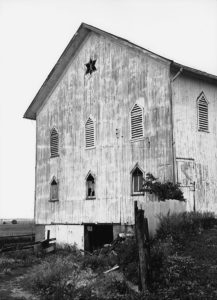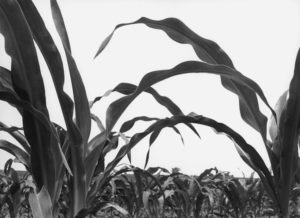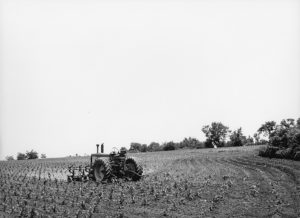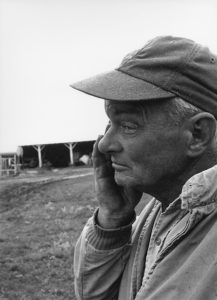This review appeared in the magazine PHOTO METRO, in San Francisco, April, 1992. Selected photos from the book are below the text.
The little girl leans against the rail and the carnival ride whirls past her. In Jonathan Clark’s photograph, “Reverie: Carnival,” this image encompasses a sense of time, immediacy and distance that characterizes Clark’s collection, “Ottawa: 1967/1990.” Clark took these photos on a family trip to his hometown in northern Illinois when he was fifteen. He printed them in 1990. The results are a stunning revelation of what was once ordinary life and now lives most in memory and myth: the mid-western American small town. The images are precious for more than historical documentation. They speak of the moment the present becomes memory. The girl is still; the ride moves on. She stays in Ottawa; the carnival will travel beyond.
The presence of the black edge of the negative bordering the prints and a white, enormous sky emphasizes the encapsulation of time. The artist acknowledges his medium. The frame creates the effect of looking through an old photo album and becomes a window. This is a picture of a very particular place in this instant of time. The vast white space of Illinois sky, however, answers with a contradictory impression as it appears to reach out of the frame forever.
In “Cornhusker,” a man in jeans, workshirt, and cap appears out of a structure and breaks into the perfect whiteness. His irregular form emerges from the line created by the nearly white symmetry of the top of the structure. He is rumpled, real, maybe better than monumental. Gazing past his work, he looks immobile.
“Ernie” is a farmer whose face is the only close-up in the collection. The astounding details of the print show the lines and creases on eyes and mouth, the salt and pepper stubble on cheek and chin, the bits of hay dust on cap and coat, and his dry, worker’s hand. The bill of his cap also juts into that white distance. Ernie is a man entirely of the present moment but with a far-away look in his eye. Neither he nor the cornhusker give clues as to what they are seeing.
“Barn” has multiple surfaces and some secret story. A profusion of underbrush—leafy, flowering, feathery or spiky—climbs a small hill toward the weathered boards and broken glass of the abandoned barn. The artist has achieved a white-on-white contrast of church-like roof and empty sky.
The technique in the entire collection is advanced far beyond either what one might expect from a fifteen-year-old with a half-frame, 35 mm camera or the current photographic scene and its focus on mixed media and body parts. In that context, this is like leaving a heavy metal performance and walking in on a concert of Bach.
Each image is rich in textures and design. The “Service Station” man creates an immense, heroic diagonal diagram with his arms. A fence made of smaller slats of wood marches up the hill alongside the “Barn.” Its boards are flattened on a different plane, and a row of ferny growth beside the fence echoes these lines showing both the lightest weight and the darkest value.
The rich growth appears again as the grass between the girl and the carnival ride. The spinning machine has been plunked down on top of the native grass. In “Tractor in Cornfield,” one senses the shape and weight of each lump of earth, the rows of young plants, and seemingly every leaf on the distant trees around the field. The minute detail within a larger design calls the onlooker to wonder at reality, the here and now of the world of these pictures
A philosophy of seeing emerges from the contrast of that cornfield with “Shale Pile.” A bare tree trunk has fallen across a barren black pile with a pitted, rough surface. Its upward curve, cut twice by the angles of dead tree trunks is crowned by a glimpse of a leafy, frilly tree top. That living prize is beyond this pile; the picture promises that it exists, but where is not revealed.
In Ottawa, there is a lot of watching and waiting. The artist, essential onlooker, shows others suspended in their own activities. A woman waits for a tire change, literally suspended in the jacked-up car, and there is no suggestion that anyone but the viewer knows that she is there. A couple looks in a sweet-shop window; a child gazes out of a train window; two men, protected by backyard shrubbery, sit calmly watching a barbecue. The artist captures himself in a self-portrait-with-camera in a rear-view mirror. This is the only reminder that this world is also autobiography. Time is not pushed by the inhabitants of these frames, nor does it ruffle them.
The world from outside Ottawa is represented in the carnival pictures. Two of them present side-show billboards for the viewer to read. Both describe the aftermath of Hiroshima. One proclaims a two-headed baby; the other issues a warning about atomic radiation: “Geneticists State Mutations So Produced Will Go Down Hundreds of Years.” If the denizens of northern Illinois see this as the best the other worlds have to offer, what advantage to corn and hogs?
The effect of us watching them watching and waiting is underscored by the artist’s appearance in the mirror. He is there but at a distance. Now part of the world away from Ottawa, his experience of coming home again is as a reflected reality.
Real time is still in this presentation of Ottawa. It is as though the people, usually alone or in pairs like the two hogs in the “Illinois Landscape,” could hold their breath and, being still, still be there. The artist shows us his “Grandmother’s Window” Through it we see her cut-glass bottles and plants, but not her. The beauty of these objects, glass window lighting glass and reflecting back, tells something about the woman who selected them, but they are still, and she is gone.
In this collection, Jonathan Clark reveals himself as an artist with an eye for the smallest forms of life who is yet not afraid to present such images in the largest world. The Cornhusker enters that vast white sky just as voluptuous leaves of corn break the emptiness with their arching growth. The magic of the here and now within these black-bordered frames is the power to present a true moment and the promise that these images are solid and real. We can watch like the people in the pictures, but we can never wait long enough to get those moments back. The honesty of the presentation, however, also suggests that to have the real is to have real loss as well.
The presence of the black edge of the negative bordering the prints and a white, enormous sky emphasizes the encapsulation of time. The artist acknowledges his medium. The frame creates the effect of looking through an old photo album and becomes a window. This is a picture of a very particular place in this instant of time. The vast white space of Illinois sky, however, answers with a contradictory impression as it appears to reach out of the frame forever.
In “Cornhusker,” a man in jeans, workshirt, and cap appears out of a structure and breaks into the perfect whiteness. His irregular form emerges from the line created by the nearly white symmetry of the top of the structure. He is rumpled, real, maybe better than monumental. Gazing past his work, he looks immobile.
“Ernie” is a farmer whose face is the only close-up in the collection. The astounding details of the print show the lines and creases on eyes and mouth, the salt and pepper stubble on cheek and chin, the bits of hay dust on cap and coat, and his dry, worker’s hand. The bill of his cap also juts into that white distance. Ernie is a man entirely of the present moment but with a far-away look in his eye. Neither he nor the cornhusker give clues as to what they are seeing.
“Barn” has multiple surfaces and some secret story. A profusion of underbrush—leafy, flowering, feathery or spiky—climbs a small hill toward the weathered boards and broken glass of the abandoned barn. The artist has achieved a white-on-white contrast of church-like roof and empty sky.
The technique in the entire collection is advanced far beyond either what one might expect from a fifteen-year-old with a half-frame, 35 mm camera or the current photographic scene and its focus on mixed media and body parts. In that context, this is like leaving a heavy metal performance and walking in on a concert of Bach.
Each image is rich in textures and design. The “Service Station” man creates an immense, heroic diagonal diagram with his arms. A fence made of smaller slats of wood marches up the hill alongside the “Barn.” Its boards are flattened on a different plane, and a row of ferny growth beside the fence echoes these lines showing both the lightest weight and the darkest value.
The rich growth appears again as the grass between the girl and the carnival ride. The spinning machine has been plunked down on top of the native grass. In “Tractor in Cornfield,” one senses the shape and weight of each lump of earth, the rows of young plants, and seemingly every leaf on the distant trees around the field. The minute detail within a larger design calls the onlooker to wonder at reality, the here and now of the world of these pictures
A philosophy of seeing emerges from the contrast of that cornfield with “Shale Pile.” A bare tree trunk has fallen across a barren black pile with a pitted, rough surface. Its upward curve, cut twice by the angles of dead tree trunks is crowned by a glimpse of a leafy, frilly tree top. That living prize is beyond this pile; the picture promises that it exists, but where is not revealed.
In Ottawa, there is a lot of watching and waiting. The artist, essential onlooker, shows others suspended in their own activities. A woman waits for a tire change, literally suspended in the jacked-up car, and there is no suggestion that anyone but the viewer knows that she is there. A couple looks in a sweet-shop window; a child gazes out of a train window; two men, protected by backyard shrubbery, sit calmly watching a barbecue. The artist captures himself in a self-portrait-with-camera in a rear-view mirror. This is the only reminder that this world is also autobiography. Time is not pushed by the inhabitants of these frames, nor does it ruffle them.
The world from outside Ottawa is represented in the carnival pictures. Two of them present side-show billboards for the viewer to read. Both describe the aftermath of Hiroshima. One proclaims a two-headed baby; the other issues a warning about atomic radiation: “Geneticists State Mutations So Produced Will Go Down Hundreds of Years.” If the denizens of northern Illinois see this as the best the other worlds have to offer, what advantage to corn and hogs?
The effect of us watching them watching and waiting is underscored by the artist’s appearance in the mirror. He is there but at a distance. Now part of the world away from Ottawa, his experience of coming home again is as a reflected reality.
Real time is still in this presentation of Ottawa. It is as though the people, usually alone or in pairs like the two hogs in the “Illinois Landscape,” could hold their breath and, being still, still be there. The artist shows us his “Grandmother’s Window” Through it we see her cut-glass bottles and plants, but not her. The beauty of these objects, glass window lighting glass and reflecting back, tells something about the woman who selected them, but they are still, and she is gone.
In this collection, Jonathan Clark reveals himself as an artist with an eye for the smallest forms of life who is yet not afraid to present such images in the largest world. The Cornhusker enters that vast white sky just as voluptuous leaves of corn break the emptiness with their arching growth. The magic of the here and now within these black-bordered frames is the power to present a true moment and the promise that these images are solid and real. We can watch like the people in the pictures, but we can never wait long enough to get those moments back. The honesty of the presentation, however, also suggests that to have the real is to have real loss as well.
All photos by Jonathan L. Clark. Top row, L to R: Barn, Corn; Lower row, Landscape, Ernie



